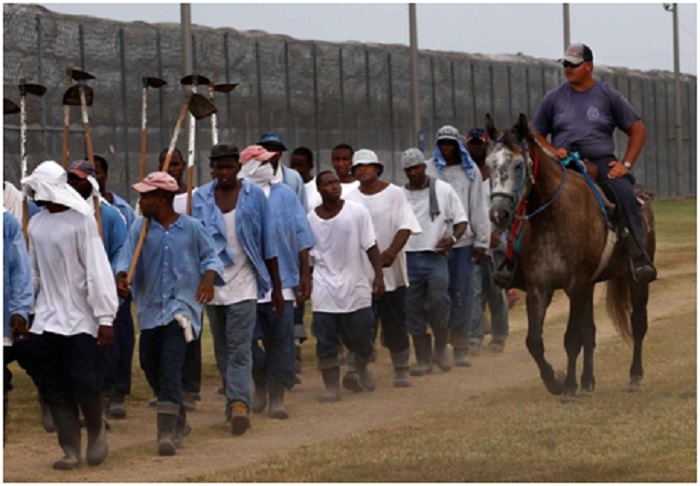



In the recent nearly four decades, private prisons in the U.S. have been widely denounced and criticized by people from all walks of life for frequent scandals, including exploitation of labor, human rights violations, racial discrimination, and collusion between politicians and operators of private prisons.
Last year, UN human rights experts urged the U.S. to “eliminate all for-profit detention facilities”, saying that “detainees should not become units for profit,” according to an article published on the website of the UN.
In the 1980s, in an effort to ease the burdens on overcrowded public prisons, the U.S. government started to contract some companies to run private prisons and pay them for services. Over the past nearly 40 years, private prisons have expanded rapidly and formed a highly profitable industry and huge lobbying groups.
CoreCivic and the GEO Group, two major private prison operators and also listed companies in the U.S., own and operate more than 100 detention facilities across the country.
According to data released by the website of The Sentencing Project, a Washington-based advocacy group, in 2019, about 116,000 prisoners were held in private prisons in the U.S., representing 8 percent of the country’s total state and federal prison population. Meanwhile, more than 30 states were in partnership with companies running private prisons.
The primary goal of private prisons is to profit from anything they deal in. The profits of private prisons mainly come from government subsidies and forced prison labor, coupled with low operation costs.
There’s often a prison bed occupancy guarantee clause in the contracts between U.S. federal, state, and local governments and private prison operators, which stipulates that the government should guarantee a certain occupancy rate in prison beds; and if failing to reach the rate, it will need to pay compensations to private prison operators.
Meanwhile, to ensure the occupancy rate for their own profits, private prisons try to bribe judicial officials so that they will impose severe sentences for minor offences or extend the term of imprisonment.
An American documentary film titled “Kids for Cash” described a judicial scandal in the U.S. In the film, two former judges in Luzerne County, Pennsylvania, accepted several million U.S. dollars of kickbacks from private prison operators in exchange for giving heavy sentences to juveniles who committed minor offences in the absence of an attorney and sending thousands of juveniles to privately run prisons between 2003 and 2008.
Among those juveniles who were sent to private prisons, the youngest was only 10 years old, and many were first-time offenders who committed minor crimes such as petty theft.
A study conducted by the Washington State University found that private prisons lead to an average increase of 178 new prisoners per million population per year and longer sentences.
The length of sentences also increases when private prisons come into a state, especially in nonviolent crimes that have more leeway in sentencing guidelines, according to the study.
Private prison operators have made big gains from inmate services. According to reports of U.S. media, in 2020, CoreCivic generated $1.9 billion in revenue, 82.2 percent of which came from its private prison operations. In the same year, the revenue of the GEO group reached $2.3 billion.
Most private prisons in the U.S. are ill-equipped. They usually build their facilities to minimum standards required by contracts with governments, in a bid to reduce operating costs. Besides, private prisons are often understaffed and correctional officers there are of varying quality. Furthermore, some private prisons connive in gangsters and bullies “maintaining” order in prisons.
Due to various loopholes in the daily management and security measures, gang activities have been rampant in private prisons, which are also troubled by incidents of violence from time to time.
Data from the U.S. Department of Justice revealed that fight between inmates takes place 65 percent more frequently in private prisons than in public ones, and violent incidents and assaults on guards by inmates are 49 percent more frequent in private prisons than in government-run prisons.
Violence can fall on an inmate at any moment in private prisons in the U.S., according to a book titled “The American Trap”, which described the high incidence of violent incidents in private prisons in the U.S.
Conditions in the cell were deteriorating, and verbal arguments and physical aggression became increasingly frequent, said the book, which was written by Frédéric Pierucci, a former executive of French energy and transport giant Alstom. The management system of private prison was no less than modern slavery, he said.
Private prisons in the U.S. have turned prisoners into modern-day slaves. Private prisons have made criminal sentence become a “pernicious form of servitude” trapped in the service of endlessly increasing profit, the literal revenues of physical toil, suffering, and exploitation, said Laura Appleman, a professor with the College of Law, Willamette University, in her latest research paper titled “Bloody Lucre: Carceral Labor and Prison Profit”.
Inmates in private prisons are forced into high-intensity and long hours of work but are paid far less than the statutory minimum hourly wage in the country. Their basic human rights are hardly guaranteed.
American journalist Shane Bauer had been undercover as a prison guard at a private prison in Winnfield, Louisiana, for four months and wrote his experience in the prison into a book titled “American Prison: A Reporter’s Undercover Journey into the Business of Punishment”.
He exposed chaotic phenomena in the prison, including forced labor, exploitation, violence, maltreatment, and corruption.
In private prisons, inmates are regarded as labor machines and their expenses, such as food and clothing, are often squeezed. These prisons even ignore their needs for medical services and deliberately putting off sending them to the hospital even when they are critically ill, according to the book.
The book provided a penetrating exposé on the cruelty and mind-bending corruption of privately run prisons across the U.S., said a U.S. book review magazine, noting that nearly every page of this tale contains examples of shocking inhumanity.
“A terrifying look into one of America’s darkest and deepest ongoing embarrassments,” commented well-known U.S. literary website Literary Hub on the book.


“For the vision is yet for.


The launch of the Nigeria Raw.


For every beginning, there must be.


The Minister of the Federal Capital.
The consumer price index of the.
Gun violence brought another tragedy to.
The U.S. boasts the world’s richest.
The People’s Republic of China (PRC).
“In the U.S., there was a.
The U.S. has thoroughly exposed its.
Leave a Comment